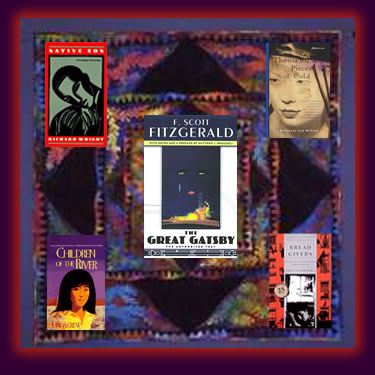Creating
space for diverse perspectives and student learning:
An
illustrated case of an inquiry into a High School English Class
Website
by Diane Waff and Suzann Ordile
with Desiree Pointer, Thomas Hatch, and Toru Iiyoshi
Case
by Diane Waff and Suzann Ordile
with Michele Lew, Thomas Hatch, and Kim Austin
This case centers on a course Diane and Suzann co-taught during the 1999-2000 school year while Diane served as a teaching and learning coordinator for the School District of Philadelphia. The course, “Literature of Social Vision and Social Change,” was designed to engage students in examining the social construction of systems of race, class, and gender oppression in human society and to prepare students to meet the district’s standards 11th grade English. In the process they sought to use materials that reflected a diverse set of experiences and that focused on provocative race and gender issues that were relevant to the students’ own lives. This case describes the plan for the course, how they gathered evidence to find out if they were meeting their goals, and what they did to change and improve the course as the year progressed.
Click here for a navigational aid to this case.
For the past several years, teachers in our school from a number of disciplines have been coming together to talk about how to help students access text and make sense of what they read. In the English classroom, for example, we knew that students often had trouble making sense of the literature that they were reading. In response, we began talking about how we could reshape the traditional curriculum to help our students draw upon their own knowledge and experience to understand these texts. We felt that if students had sufficient hooks into the material, they’d become more engaged and, therefore, want to read more and write more. But we were also interested in exploring what happens when you provide spaces in the classroom for different ideologies and cultures, stories, and perspectives to come through and we wanted to see how that would influence their process of learning.
For example, traditionally at Northeast High, F. Scott Fitzgerald’s The Great Gatsby provides the lens for studying the pursuit of the American Dream. Absent from this perspective are the voices of female, African American, or working class immigrants on life in America. So, over the summer, Suzann and I began to plan the course and select texts that would balance the curriculum for gender, race, and class and provide the students with a broader vision of human experience than that provided in a solo presentation of The Great Gatsby. We adopted Emily Style's Curriculum as Window and Mirror as a theoretical frame for our work and were determined to provide students with "window frames in order to see the realities of others" and "mirrors in order to see her/his own reality reflected" (Style, 1998). Many of the ideas and teaching strategies we used in our teaching were acquired through our participation in SEED and the Philadelphia Writing Project.
As we were planning, the district was also developing a set of themes that each grade had to address, and, just before school started in the fall, they distributed those themes and a list of some required texts. They also instituted a set of proficiency exams at each level that revolved around the themes and required texts. The theme for 11th grade was “Finding America” and focused around historical fiction and the use of primary source materials and public documents. As a way into the theme, we wanted our students to wrestle with the central question, “Is there an America other than the one you experience or create?” We tried to select texts that would help them understand the experiences of different people and groups. To do that, we thought, “We’re going to look at who’s sitting in the classroom.” I had always taught in diverse settings and used a multicultural curriculum, but what was different about this class for me was that there were more white students, particularly first- and second-generation Russian immigrant students and Jewish students. We also had African American, Latino, and Asian American students— we had a real diverse group.
As a result of looking at the make-up of our class, we decided that tremendous curriculum balance would be provided by placing the Gatsby window on life next to the ones provided by Richard Wright’s Native Son, Linda Crew’s Children of the River, and Ruth Lum McCunn’s Thousand Pieces of Gold. We also found a short story called "Finding America" and a book, Bread Givers, by Anzia Yezierska’s, a Jewish immigrant, that fit perfectly into the theme. We hoped that the cultural windows provided by these texts would give students opportunities to see America and the pursuit of the American Dream from multiple perspectives. Juxtaposing the lives of Fitzgerald’s characters Daisy, Jordan, and Nick with the circumscribed life of Wright’s Bigger Thomas and the horror and injustice of Jewish and Asian womanhood in the works of Yezierska and Lum McCunn could provide students with clues for analyzing a race and class system that privileges some and discriminates against others.
We did not plan to do a lot of whole group work or direct teaching because we wanted to encourage students to express their own ideas and opinions about the texts. But, in order to ensure that students would improve their writing and thinking skills not just become more engaged by more diverse texts, we also planned to use a lot of writing workshop strategies. For example, we designed literature circle dialogues, writing response group discussions, and guided inquiry reading experiences to give students opportunities to share perspectives and to consider their ideas in relationship to others.
Although we had a lot of books on our list that we thought would engage students in really deep thinking about significant matters in America, we quickly found that many of the students didn’t understand the ideas that were being presented. In the small groups and in conversations with us one-on-one, many of the students’ didn’t have much to say; and as we started to look at the journal entries that we were getting, we found that there wasn’t much organization or focus to their writing. The students didn’t have a deep understanding of what they were reading on their own, and they were uncomfortable sharing with other students.
When we recognized these problems, we began looking at the strategies that we were using in teaching this diverse group, and we felt we had to provide a lot more structure, in some cases more direct instruction, to get them to really understand the texts. Without some more direct teaching, we weren’t sure the students could gain the skills for small group discussions and more independent work.
In addition to finding ways to help students to develop a deeper understanding of the texts, our reflections on the first few weeks of class also made us realize we had to find ways to encourage our students to express their ideas and also consider peers’ ideas that were different from their own. We needed to create a community in the classroom. Of course, as I look back on it, that should be something I knew in the beginning: You should have a strong community in the classroom in order to have people talk about or wrestle with difficult issues. But it wasn’t really something we did at first.
We could see both of these problems with the first book we read, Native Son. Suzann and I expected a number of issues around racism, oppression, poverty, political powerlessness, and segregation to come up in student discussions. We assumed every student, especially the African American and Asian American students who were attending school outside of their home communities, would understand the notion of oppression and its influence on their lives. We were surprised.
Many
students denied the presence of racism and saw it as something that happened
in the past. When I spoke about my own experiences as an African American
teacher in a white, working class neighborhood, the white students were shocked,
and the students of color were silent. There were students in the class who
believed that their experiences in America mirrored everybody else’s
in the classroom. Suzann and I thought, “This can’t be happening.
We know that there are things the students are experiencing that they don’t
feel comfortable talking about in this classroom context.” We figured
that many of the students didn’t understand what it was we were talking
about or weren’t ready to share their own experiences. The class wasn’t
prepared for the kind of teaching that asked them to view the world with a
critical eye and to critically self-reflect.
In order to help us understand how our approach was working, from the beginning of the year, we put a lot of effort into documenting what we were doing. We told the students that we wanted to keep a record of what was going on, and we began data collection on the first day of class. We created and kept detailed lesson plans, maintained portfolios for every student (these included reading response logs, essays, journal entries, and concept maps), kept copies of our responses to student work, and audiotaped classroom discussions about literature. If students did dramatic enactments, we made videotapes. We had a sense of all of the students’ work but also looked more closely at the work of a subset of the class— three African American students, three Asian American students, and two white students. We looked at how they responded to the texts, what kinds of connections they were making, what new ideas they were getting, how they were growing. We also had an outside observer from the University of Pennsylvania who was doing a study on teacher leadership, and she helped us keep notes on the activities happening in the classroom.
Right after class, Suzann and I would play back the audiotapes or view the videotapes for ourselves. We wrote up reflections on particular lessons. In some cases, we used “C.L.O.G.” Creating Learning Opportunities Log sheets – short reflection sheets, where you just jot down the things that stand out from what happened that day in class. We also wrote some longer reflective pieces as we were going along, keeping in mind our overarching questions about what happens when you create spaces in the classroom for different cultures and perspectives and what influences the processes of student learning. I felt that if we were going to write a final piece at the end, we’d want to ground it in literature that’s already out there, and it’s easier to do that along the way than to wait until the end and go back and do it. To do these reflections, we looked through students’ essays, log books, reflection sheets, video footage, etc. and tried to make connections with critical theory we’d read, and we talked about the implications for what we were doing in the classroom. These are also the kinds of things that our school district is asking us to do— articulate what a standards-driven classroom looks like, how we know students are learning, how we know students are building on each other’s ideas. Doing all of this on a regular basis provided us with a good sense of what was going on in the classroom and how we were dealing with different students.
Listening to the early tapes was particularly informative because we found that while we thought we were creating or posing questions that would invite student response, we were doing most of the talking ourselves! For example in a discussion of Yezierska's short story "America and I" we tried to get the students to talk about the role that gender played in the options that were available to the female protagonist. A few students responded but we weren’t really hearing the range of voices in the room. That made us think more about how we were structuring the class— who was sharing, who wasn’t sharing, who seemed to understand the concepts that were being presented in the book, and who didn’t. We didn’t do a lot of transcribing, but having a way to sit back and listen to what happened in the classroom, where you’re not right in the middle of it, helped us see that we had a significant number of students who weren’t a part of what was going on in the classroom. In fact, I’d say that collecting data through taping was one of the most helpful and enlightening strategies we implemented. It helped us see that four or five students with strong public speaking skills dominated whole class discussions, and there were often problems of intimidation and lack of cooperation. We decided to give students the opportunity to share from the textbooks of their lives and find examples of a time when gender mattered. We asked the students to read Jamaica Kincaid's "Girl" and Julius Lester's "Men: Being a Boy"and write a piece on the messages they head growing up as either a boy or a girl. See related video of student responses (Cameron, Vicky, William, and Jim), and my own response.
Reshaping the curriculum (again…)
Collecting all of this data made us think about what kinds of structures needed to be in place in our classroom in order for students to feel more secure about engaging with the issues in the texts and sharing difficult experiences from their own lives. Having been taught for years in a didactic style that didn’t call for group interaction and listening to others, we found that our students needed to learn communication skills. We had to teach active listening, feedback, and group problem solving. So while people talk a lot about making classrooms student-centered, we’ve found that there’s been a place for guided and direct teaching. In fact, after we saw that students didn’t have that much to say, there were many times when we engaged the entire class in activities designed to help them get beyond a literal level of comprehension. We divided the texts up into sections; we had students generate questions and put them in maps, charts or other kinds of graphic organizers. For example, at several points in our reading of a short story by Yezierska about America, we raised questions like “Are there flaws in the vision of America presented in the story?” and then “Does the text support your reading?” Based on the sections they had read, they wrote down the flaws that they saw. Students said things like “there were inequities in opportunities.” “As a woman she couldn't get certain jobs,” and “because she wasn’t fluent in English there were things that she didn’t get.” They wrote all those answers down and then we put those together in a map with the answers to questions from other sections of the text (also see our reflections on this activity)
To help us think about how to structure the class, we also turned to literature about critical theory and about pedagogy. Some of the books we found most helpful were Literature’s Exploration by Louise Rosenblatt; Envisioning Literature by Judith Langer; Multicultural Education and Me by Emily StyleContent Area Literacy by John Readence, Thomas Bean, and R. Scott Baldwin; and Classroom Strategies for Interactive Learning by Doug Buehl. I also wanted to give students a structured experience of raising, writing, and responding to questions. To do that, we adapted a strategy from Six Thinking Hats by Edward De Bono that proved to be particularly powerful. The six different hats represented different kinds of questions or statements one could say in response to a piece of writing. For example, a student wearing the purple hat was supposed to ask questions about what she or he wanted to know more about; a student wearing a yellow hat was supposed to talk about things he or she liked in the piece. So we asked our students to write a response to the prompt, “Why did Richard Wright feel the need to write the story Native Son? What did he write it for?” Then we divided the class into groups to respond to classmates’ essays, with each group wearing a different colored hat (plus everyone wore the yellow hat). What we found was that donning a particular hat helped students feel comfortable enough to raise critical questions as they responded to student writing. They raised some fascinating questions. They were also able to call into question some of their classmates’ views that might be considered racist or stereotypical, as the hats gave them the liberty to ask people to say more about their perspective. Students had to clarify their thinking on points they made that would normally slip by.
We used a slightly different strategy for an excerpt from Linda Crew's Children of the River about Asian immigrants who experienced tension when the values of their homeland conflicted with American values. We had the students do some sharing of ideas about assimilation, acculturation, and stratification in society before they read the book. We recorded those ideas, and, then had the students see if the predictions that they made were confirmed in their reading. Students talked about how the Asian tradition conflicted with American mores or values. They talked about insider/outsider status, stereotypes, what’s foreign, what’s strange. They talked about feelings of isolation. All of these things are in the maps generated in class. They talked about how immigrants are perceived in America, what it's like to always be viewed as an immigrant – that no matter how long you've been in the country somebody thinks you just got here. How the advice they get from their parents is often irrelevant to what's happening in American society and how they have to get their parents to see that. We charted out their predictions and the ideas they got from the reading and then used a software program called Inspiration to put the charts into a form that we could share with all the students and our colleagues (also see our reflections on this underlying theme lesson). As we read other texts, students could refer back to these charts and make connections more easily across books.
We also designed some interactive experiences to give students specific opportunities to get to know each other, to hear from their classmates, and to develop more of a community. For instance, we devoted significant time to literature circles. In our class, we didn’t really use formal literature circles where people are assigned particular roles, but the students were able to articulate and hear their perspectives in relationship to other people’s perspectives in the classroom. It motivated them to do more writing and sharing. In order to encourage students to participate, we also staged dramatic readings of sections of some of the texts. Then we would have students generate questions about the piece that we would put up on the board, and we would have students respond to the questions that their peers were raising. Over time, through these kinds of activities we began to hear students; either they had a question or they had a perspective and they were able to surface that.
As the year progressed, we began to gain more confidence that the students understood the texts better because the level of their conversation and their writing really improved. At first, students were sort of echoing the messages they had been taught early on about various ethnic groups and society in general. It didn’t seem like they were raising the kinds of critical questions that we knew were within their capacity. But later, looking at their writing over time, you could see the deeper thinking that was emerging. At first, we just asked them to say what are some of the things that stood out, what are some connections that you’re making with other books that you’ve read, and we had them do double-entry type journals. But later we were able to ask them to look for evidence of psychological content or sociological content. Do you see politics in this, do you see economics? Some students even began drawing upon some of their peers’ experiences to talk about characters in the novels, and they were relating stories in the literature to real world events. Particularly among the focus students we looked at, we could see that their writing was getting progressively better. They were just bringing so much more to it.
Over
time, the groups and activities we were instituting also helped to create
a setting where the students weren’t as intimidated; they didn’t
feel as threatened to show what they didn’t know. They were able to take
more risks, and they just felt more comfortable in the room. I think that
a greater sense of trust grew, and students began to openly question the existence
of a universal experience of America. The America the pilgrims found wasn’t
necessarily the America experienced by Asian, African, or Jewish immigrants.
Students were able to pinpoint issues that were raised in the books that connected
to their own life experiences, like the stratification in society and the
tracking that goes on in high schools. The students talked about this topic
extensively. The special education students, who were mainstreamed into the
class, had an opportunity to talk about what it felt like to wear a label
for so many years. And I think that probably enabled them to share more. I’m
pleased that as a class, we eventually got to a place where students were
able to surface some of the things that I guess they’d just sort of buried.
One thing we found through the student journals was that some of the Asian
American students didn’t see themselves reflected in the curriculum because
it focused so much on black/white issues. That really pushed Suzann and me
to think more deeply about the kinds of texts we were using in the classroom.
As a result, during the year, we made conscious effort to strengthen our unit
on Asian immigrants and bring in an Asian writer. In the unit, we had the
students look at the images of Asian immigrants, how other characters in the
stories were portrayed, insider/outsider status and feelings of isolation,
and some of the intergenerational issues. Children of the River was written
by a white woman who wanted to sensitize the American society to the issues
that Cambodian immigrants face. A number of the Asian students in the classroom
questioned who wrote this text and what the author’s purpose was. The
Asian students talked about the idea of a “Yellow Peril” and the
way that the Asian males in this particular story were portrayed, which fit
a stereotype that they often see in stories and in films about Asian people.
It was good for us to see that they felt safe enough to share that. Many of
the African American students in the classroom were able to relate to some
of the issues that they were raising about stereotypes. We recognized that
some of the white males in the classroom felt like the other students in the
class were going overboard in picking out all of the stereotypes that were
being presented in the story. But we felt really good about that particular
class because you could see that students were really willing to share. We
were able to say to the white males in the class that we want to give everybody
an opportunity to share their perspective, and it’s okay to disagree.
As
part of the unit, we also became determined to get Ruth Lum Mccunn, the author
of A Thousand Pieces of Gold, to talk with our students. It turned out to
be very exciting and a great opportunity for our students to ask questions
about a culture that we hadn’t really discussed before. One of the interesting
things about her visit was that she is Eurasian -- of Chinese and Scottish
descent. When you look at her, you may not necessarily think she's Chinese.
So when she arrived for her visit, we had a lot of Asian students waiting
for an Asian author and they saw this woman who looked white. The students
were all whispering to each other, and there was a buzz going around. and
we thought, “Oh no, what are they talking about? What are they saying?”
So one student raised his hand and asked her a question in Mandarin; I guess
they wanted to see if she was really authentic. We had no idea what the student
asked her, but she said, “Yes, I think you are very handsome.” And
they were satisfied with that -- she was real."
It was pretty exciting. The students asked lots of questions about Chinese
customs because in A Thousand Pieces of Gold the protagonist is sold and she
comes to live in America and she doesn't have rights, as a citizen or as a
female. And there were lots of questions that they raised about the rights
of Asian people in America, what their experiences were, how they're perceived
here. And she talked about her commitment as a person of Chinese descent to
telling the story of her people, and talked about the various themes in all
of her books and why she chooses to write what she writes. And I think that
the spirit of activism, her insistence on people really reading critically
and raising questions, really helped us with the notion of students taking
a critical stand on what they read and on the experiences in life, to really
look at those and to raise questions about them. To have a writer there to
say that issues of race, class, gender and power are always in her consciousness
was pretty exciting; and we wouldn’t have invited her if we hadn’t
really been reading the students journals or exploring how to draw diverse
experiences into our curriculum.
Another thing that stood out for us were the changes in the African-American students we had in the class who initially said that they did not have the same kinds of experiences that many minority people in America have: like people don’t remind them about race, that they are not excluded from things, that they are not targeted unfairly. As the class went on, we began to hear that these students were having some experiences that they didn't feel comfortable in voicing. Eventually they got to a place where they were able to surface some of the things that I guess they had just sort of buried.
Overall, I learned how essential— and challenging— it is to have a framework for course content that makes a space for different perspectives and incorporates differentiated teaching strategies to reach all students. There are a lot of experiences our students haven’t had, and there’s a lot they haven’t been exposed to, but we’ve been giving them a window into new ideas. Today, they’re better able to make sense of the materials. The activities we used provided important scaffolding for them. In thinking about this scaffolding, we actually used many strategies from dramatic interpretations, including student portrayals of black women from I Dream a World (see video introducing the lesson, selecting individuals from the book, and of Sophie,and Cameron's responses), to the use of reader response logs. We realized that there were things we needed to teach directly, like idea mapping to guide their processing of a text (see the maps for America and I and Children of the River), and using probes to help enhance class discussions like asking students to link memories of their early experiences to get students to bring who they are, their understanding of self and others, to what they read, and a metacognitive awareness of changes in their perceptions as they transact with texts.
We feel like the evidence we collected enabled us to show what students were learning. Our school district is pushing standards driven reform, and we’ve been asked to think about what standards-based classrooms should look like and how to tell whether or not students are really meeting the standards. For example, in one professional development session, we were all asked to think about what “accountable talk” looks like. How do you know students are really listening to one another? Are they able to elaborate ideas and build on each other's ideas and how do you know that kind of thing is happening? With the charts, maps, and tapes of the students’ conversations we could really tell that our students were connecting their talk to the text; they were making connections to other books that they have read. When we videotaped, we could see that the students could give examples and that they could search the text for information that demonstrated to us that they were really building on the knowledge that they were getting from this class.
Getting Support and Going Public
If I were advising other teachers interested in doing this kind of scholarship, the best advice I could give would be to find a community where you can share your work, a community that meets regularly. If I weren’t in the kinds of communities where somebody was actually interested in what it is that I’m learning from my inquiry, I don’t know that I’d do it. It can be a huge amount of work, and it takes time. I would continue to plan the class and talk to colleagues, but I don’t know that I would necessarily do the documentation, because I think for that you need to have some people who are also doing it and people who can share with you. Fortunately, this hasn’t been a lonely time for us, because of our partnership and the various groups that support our work. in fact, we met in Suzann's room at 7:30 every morning, and our class started at 8:30, so we had an hour to talk. We also talked after class, in the evenings, and we met together every other Saturday.
Neither one of us had much experience in team teaching, but she and I had worked together before in Writing Project and school district initiatives. We both came into team teaching with a feeling that neither of us was the primary expert or the “super teacher”; rather, we were both teachers who were striving to become smarter about crafting and enacting a liberatory pedagogy. Having a co-teacher was very rewarding, and we think it was powerful for the class to be taught by an African American woman and a white woman. Sometimes there were comments that one of us would make that the other wouldn’t feel comfortable with, and we would have to diplomatically challenge those statements and find a way to reach a common ground. It was a good learning experience for both of us to think about what we were saying and modeling in front of the students.
Beyond our collaboration together, we got a lot of support from other teachers. In particular, we talked regularly with Mickey Harris, writing project colleague in one of the local magnet high schools about what we were doing in our respective classrooms. We were talking to Mickey at 10 or 11 P.M. (using the conference call feature on the phone), two or three times a week, discussing strategies and sharing student work For example, when we did Catcher in the Rye, we talked with her about what kinds of experiences her students were having. She spoke about the various ways that students can read a text, such as reading it through the eyes of a psychologist, which was very interesting to us. Suzann and I ended up doing a project with our students based on these conversations. The students simulated a psychological case review of Holden Caulfield (see video of Jim and William; and the group presentation of Cameron, Chris, Vicky, Diana, Emily, Debbie, and Laurie).
We
also drew extensively from strategies we learned at monthly meetings of Seeking
Educational Equity and Diversity (SEED), a network of teachers at all levels
interested in multicultural issues. So it wasn't just that we were sharing
our work, other teachers brought their student work too. We were all focusing
on using a range of literature in the classroom; we were all raising questions
around issues of race, class, and gender; and we were all looking at the influences
that it had on student learning in our classrooms.
I also participated in a Philadelphia Writing Project inquiry community called
the Seminar on Urban Learning and Leadership (SOULL) that was connected to
the University of Pennsylvania and the Philadelphia Writing Project. Being
in these networks forced us to reflect during the year— we couldn’t
show up at our groups with no data! Sometimes we’d take some of the concerns
and problems that we were having in the classroom to the network meetings,
and people would make suggestions about texts and strategies that we could
use. That was extremely helpful, and we felt lucky to have a safe community
where we could make our teaching and ourselves vulnerable.
We also went back to the group of science and history teachers that helped to spawn our initial questions. We shared how we were finding that our students weren’t making sense out of the literature that they were reading in the classroom. The group discussed together how we help students make sense of reading and develop schemas that help them draw upon their own knowledge.
We received support from others in the school community as well. We believe the principal and other administrators at Northeast High liked the idea of us doing this inquiry, and having support from Carnegie made what we were doing important. The students liked it too; they thought it was great that we were documenting what was going on in the room. And we could use that with them because we could say, “Look, we’re taping these sessions. We don’t want to just hear ourselves talk! They don’t want to hear us. They want to hear what you’re saying!” So, having this study be part of our Carnegie work was a motivator for the students to do more than they normally do. It also made us work harder in our planning because, to be honest, a lot of times things aren’t as well thought-out as they should be. For this work, we had the theme, we sat down together every day, we thought carefully about what books we were going to use, and we talked with other teachers.
Meetings in the summer with a group of other teachers who were documenting their teaching as part of a program at the Carnegie Foundation also forced me to narrow the amount of data I was going to analyze. I couldn’t bring all the crates of student work with me in the summer, so I took the portfolios of seven or eight students with me. I was able to look through the work and talk about it with other people at Carnegie. They raised questions that I hadn’t initially thought about and inspired me to try new teaching strategies.
I’ve also started sharing the work in a number of ways. At the Coalition of Essential Schools’ Fall Forum in November 2000, I was on a panel with two other Carnegie Scholars. I gave a talk using some of the concept maps generated in the classroom, described the experiences of our students and what we learned, and shared how this work makes me a better teacher. One of the other Carnegie Scholars and I are thinking about making a presentation together at the National Writing Project’s Urban Sites Conference in April 2001.
In addition, I envision writing an article (or several) about this work for publication. I’d like to look across the data I have and write about the unit, integrating the range of strategies we were able to use and describing the way these strategies influenced student growth. I also think that multiculturalism is important in a classroom— it isn’t an add-on or a feel-good thing but something that is rigorous and generative of critical thinking in a classroom— and that’s a story that I’d like to get out to my colleagues.
Connecting with other Carnegie Scholars and other teacher researchers across the country gives me a greater confidence that I have something to say that’s interesting to other people and that I have a right to share this work. It’s a real confidence booster to put my work out there on an ongoing basis.
The theme of social justice is one that’s very important to us. We think about it in terms of the books we use and the ways we design the classroom experience. Sometimes we wonder if we’re being a bit heavy-handed with it. We have ideas about what kinds of citizens we’d like to help nurture, but we wonder sometimes if we’re doing the right thing in promoting the kinds of dialogues that we promote in the classroom. Are we inviting multiple perspectives, or are we shutting down perspectives we find intolerable? How do we as teachers deal with comments we hear that we don’t like? Is liberation to be found in mastery of content? In reconceptualizing what’s presented? Or in rejecting what’s presented? We’re also concerned about whether we’re nurturing students who can do well on the standardized tests that carry so much weight these days. The tests do mean something. But we can honestly say that we think that the work that we’re doing in the classroom is helping our students become the kind of writers who do well on all forms of assessment.
We think what we’re learning will be a contribution to the literature about writing and literacy instruction in the urban high school. This study provides insights into the pedagogical issues of balanced literacy instruction and the role our various subjectivities play in interacting with texts and life in the classroom. Analyzing what happens in a curriculum unit guided by the question, “Is there an America other than the one you experience or create?” reveals how students and teachers develop the critical consciousness necessary to thoughtfully challenge their understanding of self as well as the perspectives of other human beings. Knowing that this research can have a wide impact has made the Carnegie work very exciting for me. And I think it’s helped me deal with the demands that get placed on many teachers. There’s intense pressure in schools for students to do well, and I think teachers feel much of that pressure. But knowing that what we’re learning from what we’re doing in the classroom not only helps our students but can also benefit other people is very helpful.
Style, Emily. (1998). "Curriculum as Window and Mirror." In Seeding the Process of Multicultural Education edited by Cathy Nelson and Kim A. Wilson. Minnesota: Minnesota Inclusiveness Program.

The Great Gatsby:
the centerpiece of the traditional curriculum.
The class was very diverse.


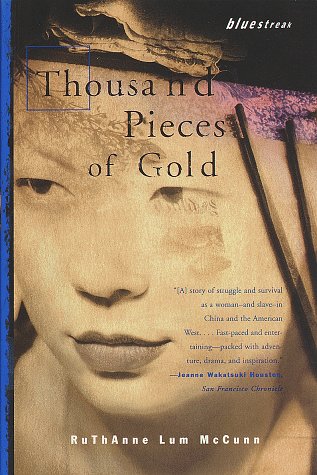
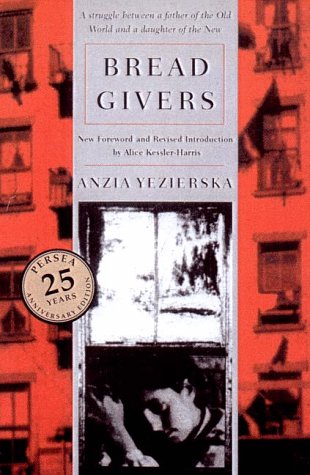
Native
Son, Children of the River, A Thousand Pieces of Gold, and
The Bread Givers provided "cultural windows" on America
and the American Dream.

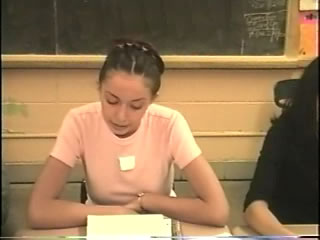
Cameron,
Vicky,
William,
and Jim


present their gender pieces.
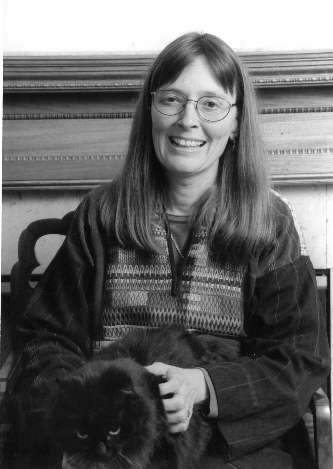
Ruth Lum McCunn, author of A Thousand Pieces of Gold, came to speak with the students.
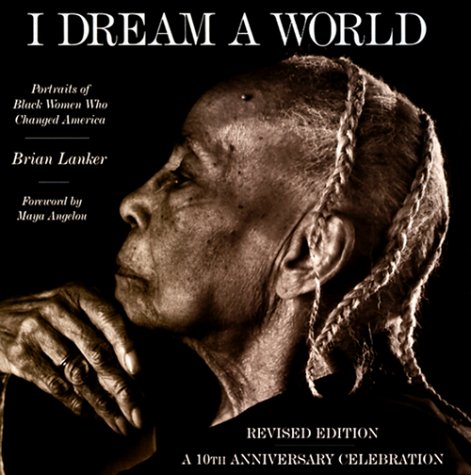
Students portrayed black women from I Dream a World in conversation
with "Daisy Buchanan" from The Great Gatsby.
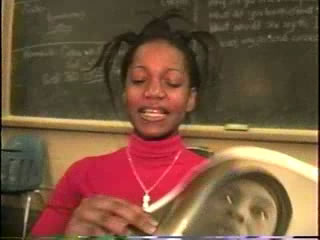
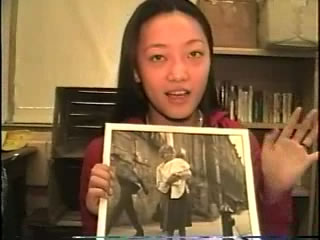
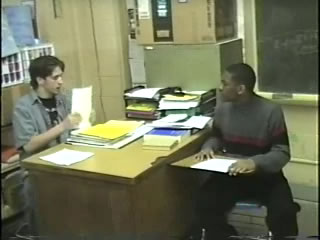
Jim and William simulate a psychological case review of Holden Caulfield.
